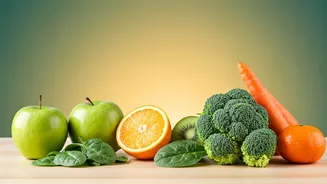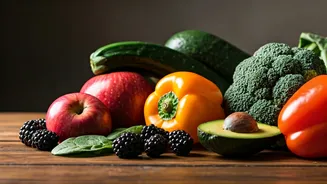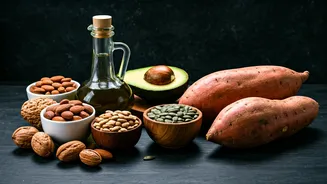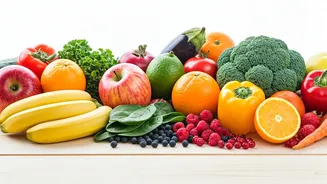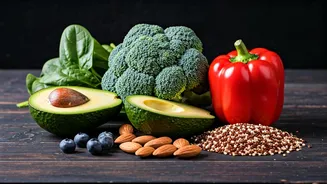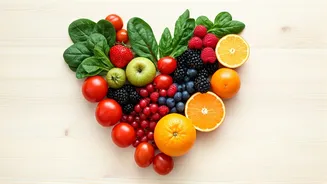Understanding Protein Needs
Protein is a crucial nutrient for repairing tissues, building muscles, and supporting overall health. It's often associated with meat, but there are numerous
plant-based alternatives that provide the necessary amino acids. Understanding individual protein requirements is the first step. Factors such as age, activity level, and health goals significantly influence daily protein intake. For instance, athletes and individuals engaged in strenuous physical activities typically require more protein to support muscle recovery and growth. A well-balanced diet that includes a variety of vegetarian protein sources can easily meet these needs, ensuring the body gets all the essential amino acids it requires. Consulting with a nutritionist or fitness expert can help determine the precise protein requirements tailored to individual circumstances.
Lentils: Protein Powerhouse
Lentils are an excellent vegetarian protein source, packed with both protein and fiber. They come in various types, including red, green, and brown, each offering unique nutritional profiles. A single cup of cooked lentils can provide a significant amount of protein, along with essential vitamins and minerals like iron and folate. Lentils are also incredibly versatile in the kitchen, easily incorporated into soups, stews, salads, and curries. Their high fiber content promotes digestive health and helps maintain stable blood sugar levels, making them a beneficial food for overall wellness. Moreover, lentils are relatively inexpensive and readily available, making them an accessible and practical protein source for everyone. Considering their nutritional value and ease of preparation, lentils are a staple that should be part of a well-rounded vegetarian diet.
Beans: Diverse Protein Choices
Beans, belonging to the legume family, offer another fantastic source of vegetarian protein. From kidney beans to black beans, and chickpeas, there is a wide array of options to choose from, each providing a unique blend of nutrients. Beans are also rich in complex carbohydrates and fiber, contributing to sustained energy levels and digestive health. One cup of cooked beans provides a substantial amount of protein, making them an excellent choice for individuals aiming to increase their protein intake. Beans are easy to incorporate into various meals, whether in salads, chili, or as a side dish. They are also relatively affordable and can be stored easily, making them a convenient option for meal planning. Combining beans with whole grains, such as brown rice, can create a complete protein profile, providing all the essential amino acids.
Tofu and Tempeh: Soy Options
Tofu and tempeh, both derived from soybeans, are popular protein sources, particularly among vegetarians and vegans. Tofu, often referred to as bean curd, is made from condensed soy milk and available in various textures, from silken to extra-firm. Its neutral flavor makes it a versatile ingredient, absorbing the flavors of marinades and seasonings well. Tempeh, on the other hand, is made from fermented soybeans, which gives it a firmer texture and nutty flavor. Both tofu and tempeh are complete proteins, meaning they contain all nine essential amino acids. They are also rich in iron, calcium, and other essential nutrients. Tofu can be used in stir-fries, scrambled, or baked, while tempeh is delicious grilled or added to stews. Including tofu and tempeh in your diet provides a good dose of protein and a variety of other health benefits.
Quinoa: Complete Protein
Quinoa stands out as a unique grain, which is also a complete protein source, containing all nine essential amino acids. Unlike many other grains, quinoa offers a complete protein profile, making it a valuable addition to a vegetarian diet. It is also a good source of fiber, iron, and magnesium. Quinoa has a slightly nutty flavor and a fluffy texture when cooked. It can be used as a substitute for rice, in salads, or as a base for various dishes. A cup of cooked quinoa provides a decent amount of protein, and it’s relatively easy and quick to prepare. Its versatility and nutritional benefits make quinoa a great choice for those seeking a protein-rich, healthy option. Whether you are aiming to increase your protein intake or diversify your diet, quinoa is a fantastic choice.
Nuts and Seeds: Protein Boost
Nuts and seeds are often overlooked as a significant source of protein, but they can contribute substantially to your daily intake. Almonds, walnuts, chia seeds, flaxseeds, and sunflower seeds, among others, offer a good amount of protein, along with healthy fats and other beneficial nutrients. These are very convenient and can be eaten as a snack, added to breakfast cereals, or incorporated into salads and other meals. Nuts and seeds also provide fiber, vitamins, and minerals. However, it's important to consume them in moderation, as they are calorie-dense. Including a variety of nuts and seeds in your diet not only increases protein intake but also adds flavor and texture to your meals. They are a simple and effective way to enhance the nutritional value of your vegetarian diet.
Combining Sources for Gains
To optimize protein intake, consider combining different vegetarian protein sources. Although some plant-based foods may not provide a complete protein profile individually, they can complement each other when combined. For example, pairing beans with rice creates a complete protein, offering all nine essential amino acids. Similarly, adding nuts or seeds to a meal that includes lentils or tofu can boost the protein content and create a more complete amino acid profile. A well-planned diet that incorporates a variety of plant-based protein sources ensures the body receives all the necessary amino acids for optimal health and fitness. By mixing and matching different sources, you can ensure a balanced and nutritious diet, helping you achieve your fitness goals effectively.
Portion Control and Planning
Proper portion control and meal planning are essential for managing protein intake effectively. While vegetarian protein sources are generally healthy, it’s important to be mindful of serving sizes to avoid overconsumption of calories or other nutrients. Planning your meals ahead of time can help you ensure that you consume enough protein throughout the day. Consider using a food diary or tracking app to monitor your protein intake and make any necessary adjustments. This helps in achieving and maintaining your fitness objectives. Preparing meals at home gives you greater control over ingredients and portion sizes. Incorporating a variety of plant-based protein sources into your meals ensures a balanced and healthy diet, supporting your overall health and well-being. Focusing on portion control and meal planning leads to more effective results.


